

Branding Guidelines

Table of Contents
Color
Secondary Color
Usage Proportions
Tints and Shades
Color Combinations
Color Guidance
4 14 18 33 34 40
Typography
Fonts
Alternate Typefaces
Hierarchy
Recommended Text Sizes
Photography
Photo Tagging Next Steps
Resources
Making Requests
Providing Feedback
Logo
Logo Clearspacing
Hierarchy
Recommended Text Sizes
Partner Logo Unit Logos
Iconography
Design Principles
System Icons
Preface
The University of Maryland aspires to “address the most pressing global challenges and inspire the human imagination,” and the Office of International Affairs (OIA) plays a leading role in realizing this ambition. OIA envisions an inclusive community that together works to advance the global common good, creating and sustaining opportunities and connections across the university’s seven colleges and five schools to address global challenges. OIA is advancing a strategic plan for internationalization, fostering and nurturing international partnerships, and developing innovative programming for faculty and students that will facilitate their development as global leaders committed to bringing out the best in humanity.
Key unit partners in this endeavor are OIA’s offices of International Student & Scholar Services (ISSS) and Education Abroad (EA). The University of Maryland has more than 170 active partnerships across the globe and typically sends over 2,000 students abroad each year on a variety of programs that focus on global competence and professional development. It generally welcomes more than 4,500 international students and 1,500 international scholars to College Park each year. Facing the COVID-19 pandemic, OIA is collaborating with partners throughout the university and the world to innovate, expand and redefine digital opportunities at the university for global learning and engagement.
Though each unit has nuanced strategic aims specific to its target audiences, these efforts tie into the broader mission of the OIA and the establishment of a Global UMD. These brand guidelines serve to align the visual elements in this unified effort.
Color
The University of Maryland’s colors are red, gold, white and black. Taken from the state flag, these colors reflect our role as part of Maryland’s flagship university. These colors should be present in most marketing and communications materials.
GOLD
BLACK
Secondary Colors
The secondary color palette expands the branding toolkit to encompass additional colors including those most commonly used in flags around the world, a nod to our mission of internationalization. The secondary colors should be used sparingly as accents, in illustrations, or to represent different moods.
RGB — 24 38 81
— 100 92 38 36
— 20 190 209
— 70 0 18 0 HEX — 14BED1
RGB — 249 188 26 CMYK — 2 27 98 0 HEX — F9BC1A
RGB — 170 123 89 CMYK — 30 52 69 9
— AA7B59 RGB — 39 110 183
— 85 56 0 0
RGB — 1 149 72 CMYK — 86 16 99 3 HEX — 019548
— 1 82 93 0
RGB — 224 46 85
— 6 96 58 0 HEX — E02E55
RGB — 200 204 205
— 21 15 15 0 HEX — C8CCCD RGB — 96 28 15
— 36 89 92 54
— 601C0F
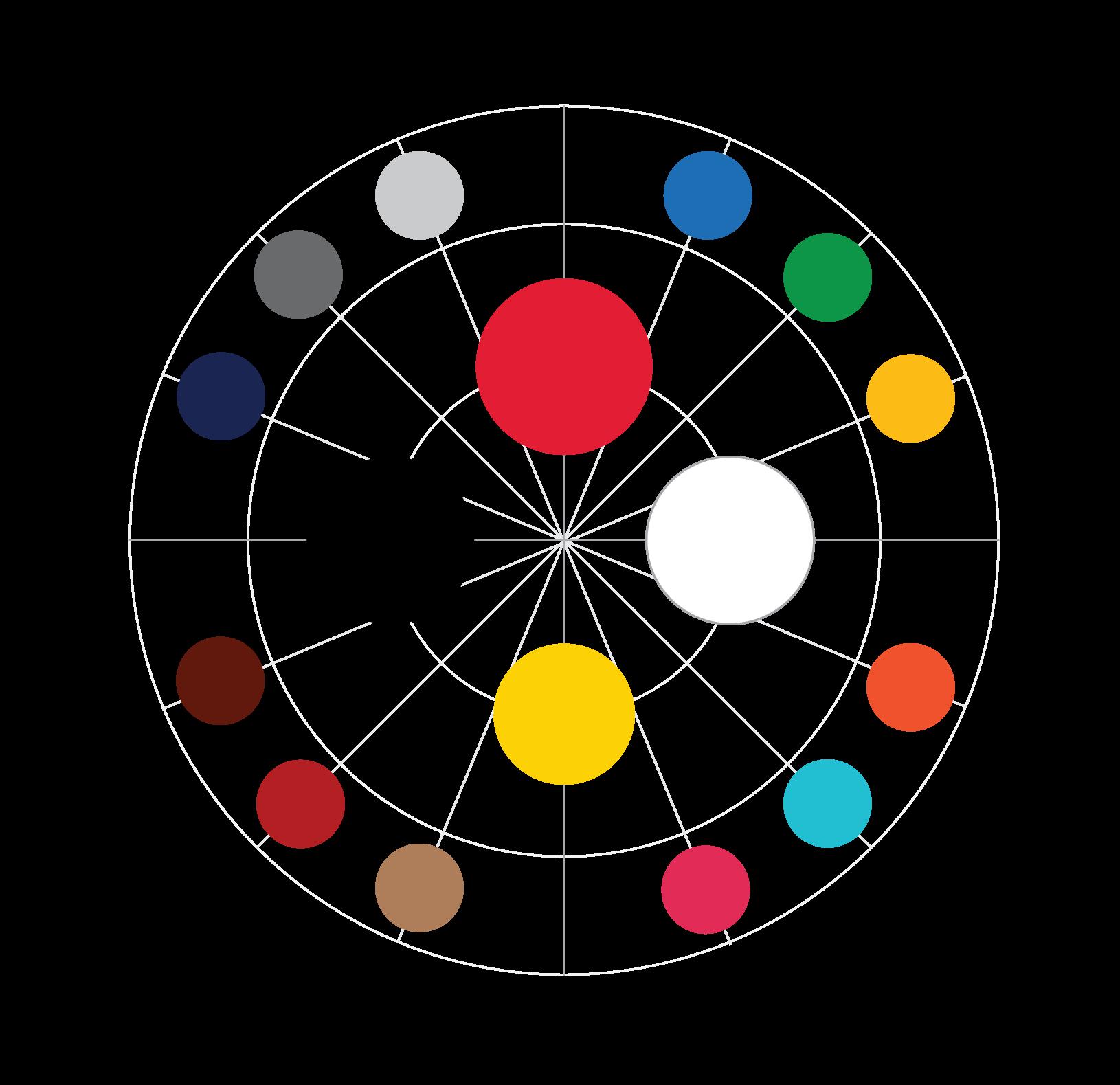
Usage Proportions
The size of the circles in the brand color matrix below relate to the weight each color should hold in branding materials. When utilizing the color palettes for new designs, it is important to maintain a sense of hierarchy. Unique and exciting color palettes can be created using as few as three or four colors.
Tints and Shades
Monochromatic Palettes
A monochromatic color palette can be made using tints (lighter versions) and shades (darker versions) of a brand color. This enables versatility and cohesiveness while staying true to the brand colors.
Tints and Shades
Monochromatic Palettes (continued)
LIGHTER
LIGHTER
LIGHTER
LIGHTER
LIGHTER
Tints and Shades
Monochromatic Palettes (continued)
LIGHTER
LIGHTER
LUCKY POINT
LIGHTER
LIGHTER
OXIDE
Color Combinations
Palette Samples
Derived from using a base hue and is extended by adding a darker color, grey, or black.
MONOCHROMATIC RED
MONOCHROMATIC GOLD
Color Combinations
Palette Samples (continued)
COMPLEMENTARY RED
Derived from using colors on the opposite of the color wheel to create a stronger visual contrast.
PRIMARY WITH ACCENT
Derived from using the university’s primary colors and accented with one or more secondary colors.
Color Combinations
Palette Samples (continued)
PRIMARY WITH ACCENT
UMD COLORS
Derived from using the University’s primary colors.
Color Guidance
Visual Examples
Do use colors from the branding color palettes
DON’T
Use other colors
Mix colors from the brand color palettes
Make sure there is sufficient contrast (red on white, black on yellow)
Deviate too much from the recommended proportions
DON’T DON’T
Don’t use light text on light backgrounds or dark text on dark backgrounds (red on black, white on yellow)
LOREM IPSUM
LOREM IPSUM
Typography
Fonts
The official typeface is Adobe Bembo, a serif book type that combines traditional forms with contemporary styling. The official sans-serif typeface is Interstate, which conveys a modern, clean aesthetic and pairs nicely with Bembo.
For access to UMD Adobe fonts, click here to access the shared Google Drive. (Bembo and Interstate).
ADOBE BEMBO / 25pt
INTERSTATE / 25pt
Alternate Typefaces
If Adobe Bembo is not available, please substitute with either Adobe Garamond or Georgia.
If Interstate is not available, please substitute with either Helvetica, Verdana or Open Sans.
ADOBE BEMBO ALTERNATIVES / 18pt
Adobe Garamond Premiere (Light)
Adobe Garamond Premiere (Regular)
Adobe Garamond Premiere (Semibold)
Adobe Garamond Premiere (Bold)
Georgia (Regular)
Georgia (Bold)
INTERSTATE ALTERNATIVES / 18pt
Helvetica (Light)
Helvetica (Regular)
Helvetica (Bold)
Verdana (Regular)
Verdana (Bold)
Open Sans (Light)
Opens Sans (Regular)
Open Sans (Semibold)
Open Sans (Bold)
Open Sans (Extrabold)
Hierarchy
Visual Examples
Organizing typography in a hierarchical system allows for readers to easily navigate content.
SAMPLE
This Headline is 48pt Interstate
This subheading is 1/2 the size of the heading at 24pt Interstate
This body text is 1/2 the size of the subheading, and 1/4 the size of the headline, at 12pt Interstate.
Hierarchy
Visual Examples (continued)
Along with text size, you can combine fonts to achieve distinction between headlines and body text.
SAMPLE
This Headline is 48pt Bembo
This subheading is 1/2 the size of the heading at 24pt Interstate.
This body text is 1/2 the size of the subheading, and 1/4 the size of the headline, at 12 pt Bembo.
Logos
Department & Unit Official Logos
The Office of International Affairs incorporates the UMD standards for the use of department and unit logos. The university’s visual identity reinforces its reputation and messages by conveying a sense of prestige, excellence and authority and its status as the state’s flagship institution. OIA, ISSS and EA advance their missions by aligning with the university’s visual identity, especially when communicating with external audiences. The following logos should be used on official communication by each respective unit.
University of Maryland Logos
RECTANGLE
SQUARE
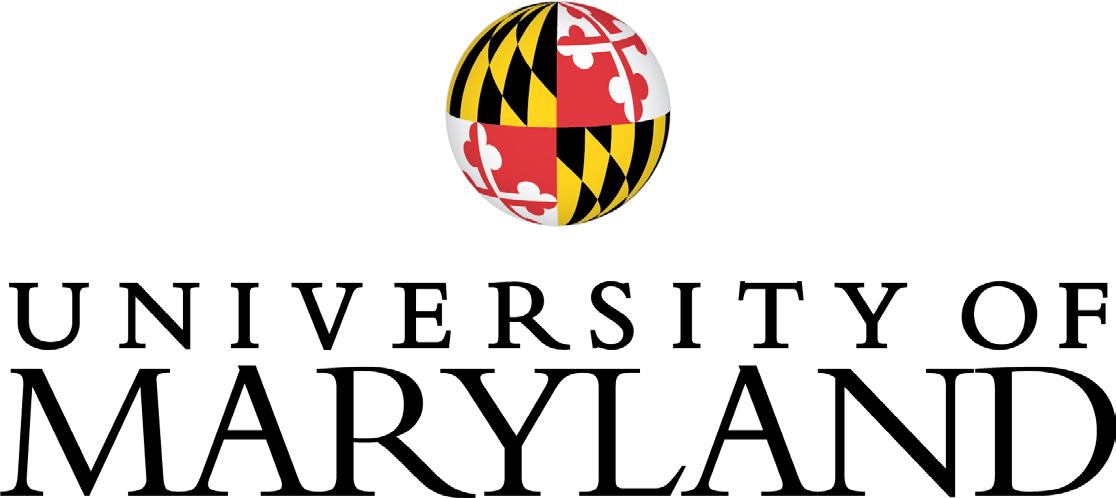
Unit Logos
OIA Formal Logo (Rectangular)
ORIGINAL COLOR
GRAYSCALE
BLACK
WHITE
Unit Logos
OIA Formal Logo (Square)
ORIGINAL COLOR
GRAYSCALE
BLACK
WHITE
Unit Logos
ISSS Solo Logo (Rectangular)
ORIGINAL COLOR
GRAYSCALE BLACK
WHITE
ISSS Solo Logo (Square)
ORIGINAL COLOR
GRAYSCALE
BLACK
WHITE
Unit Logos
ISSS Formal Logo (Sub-unit of OIA)
ORIGINAL COLOR
GRAYSCALE
BLACK
WHITE
Unit Logos
EA Formal Logo (Rectangular)
ORIGINAL COLOR
GRAYSCALE
BLACK
WHITE
Unit Logos
EA Formal Logo (Square)
ORIGINAL COLOR
GRAYSCALE
BLACK
WHITE
Logo Clearspacing
Clearspace around the logo is equal to the height of the University of Maryland symbol. Ample spacing is to ensure that a logo maximizes visibility and impact.
RECTANGULAR LOGO

SQUARE LOGO

MINIMUM SIZE
Avoid shrinking logos below 5/8” or 73 pixels to ensure legibility.
Partner Logo
Aligning partnership logos should follow clear space rules. The separating line between logos can be created by using half of the size of the width of the University of Maryland symbol.
SAMPLE GRID


SAMPLE SPACING

Examples of EA Branding
Here are examples of branding to promote the Education Abroad Fair, adapted for the new guidelines.
ADVERTISEMENT














The UMD experience extends beyond our College Park campus. Gaining a global education is key to success in our increasingly interconnected world. Study abroad offers a chance for personal and academic growth, but also an opportunity to shape the future of the world we all share. As a Terp, you can take advantage of opportunities to gain intercultural skills that help you to reach beyond national borders and work collaboratively with international colleagues to create world-changing impact.
Studying abroad not only changed my college experience, but my whole future.
- Brittany Spraker, Summer 2017
During my time abroad, I learned how strong I am physically, mentally, emotionally and spiritually.
- Jasmine Namata, Fall 2019

8 out of the top 10 companies in Maryland are multinational.
in
23% of UMD students study abroad before graduating (twice the national average!)
Studying abroad promotes new perspectives, ideas, relationships and ways of understanding your place in the world.
scholarships each year
400+ programs spanning across semester, yearlong, short-term, exchange and affiliate partnerships

Global Classrooms
Logo vs. Graphic
Respecting UMD brand standards, Global Classrooms will transition from its previous "Global Classrooms Initiative" logo to a graphic treatment that falls within the OIA branding guidelines umbrella. A Global Classrooms graphic should always be used in conjunction with the OIA logo to clarify that Global Classrooms is part of OIA and UMD.
Labels and Banners
Two general sizes of Global Classrooms graphics will be available in the OIA Branding & Marketing Resources toolkit.
• Labels may used on letterhead or in other situations where smaller branding is necessary.
• Banners may be used as either a standalone graphic or as part of a larger visual.
Either treatment may be used across promotional materials, in alignment with the other guidelines outlined in this document. Additional graphics for Global Classrooms are available in the toolkit, including some more colorful backgrounds. Those more colorful options should be limited to less formal digital materials, such as social media, the website or slideshow presentations.
Sample Graphics
LOGO & GRAPHIC COMBINATION
LABELS



BANNERS

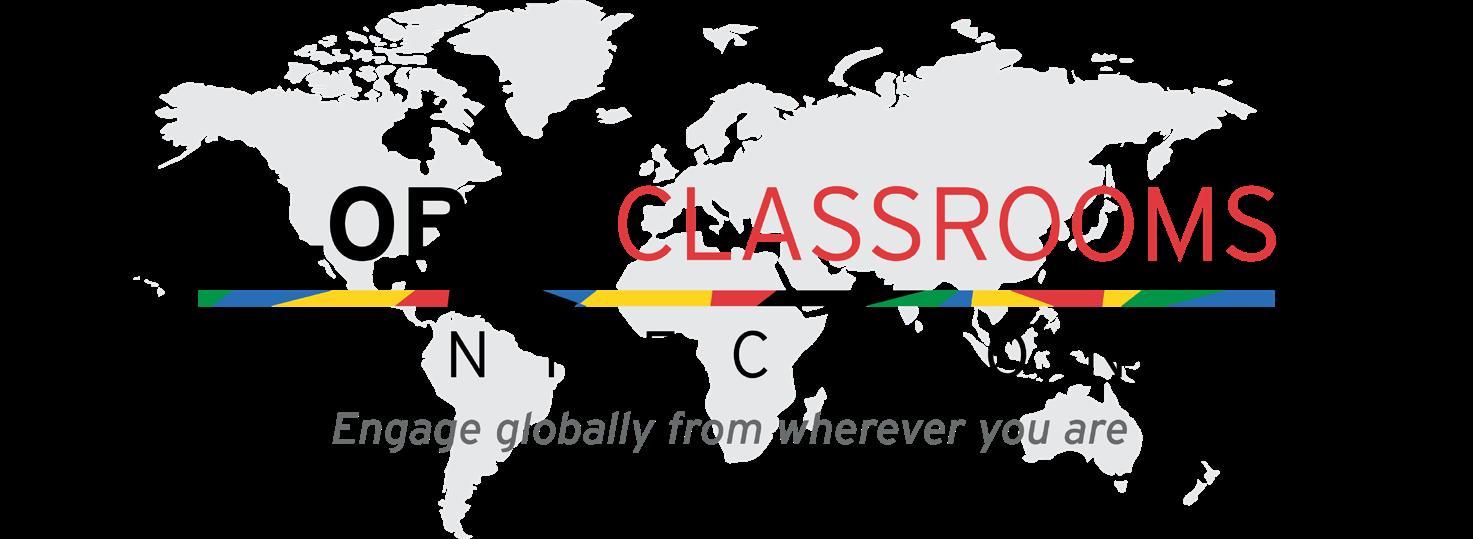

UMD Word Mark Only
The UMD word mark can be used without the symbol when designing with one or two colors. It can also be displayed on collateral where the symbol would clash with other design elements. You may choose to use the word mark in conjunction with your unit or department logo to emphasize a UMD affiliation without the redundancy of the UMD seal. If taking this approach, be sure not to merge the two into one logo and apply the appropriate clearspacing if using them close together.
SAMPLE

SAMPLE

Iconography
Use of icons in publications and design should come from either OIA’s set of custom icons or Google’s Material Designs by accessing the shared drive here. System icons are designed to be simple, modern, friendly, and sometimes quirky. Each icon is reduced to its minimal form, to express essential characteristics.
SAMPLE OF ICONS (24 x 24px)

Design Principles
Icon shapes are bold and geometric. They have a symmetrical and consistent look, ensuring readability and clarity, even at small sizes.
System Icons
System icons are displayed as 24 x 24 pixels at minimum size. Create icons for viewing at 100% scale for pixel-perfect accuracy.
Photography
Engaging images are an important part of conveying the value of international collaboration and education. Here, you will find resources and guidance for using photography and imagery to enhance brand reputation.
These are some suggestions you should consider for incorporating high quality images into your communications material:
Feature Real People
Photography Samples
Showcase the one-of-a-kind community of faculty, staff, and students that surround us every day at UMD and abroad. Only use stock photography when completely necessary.
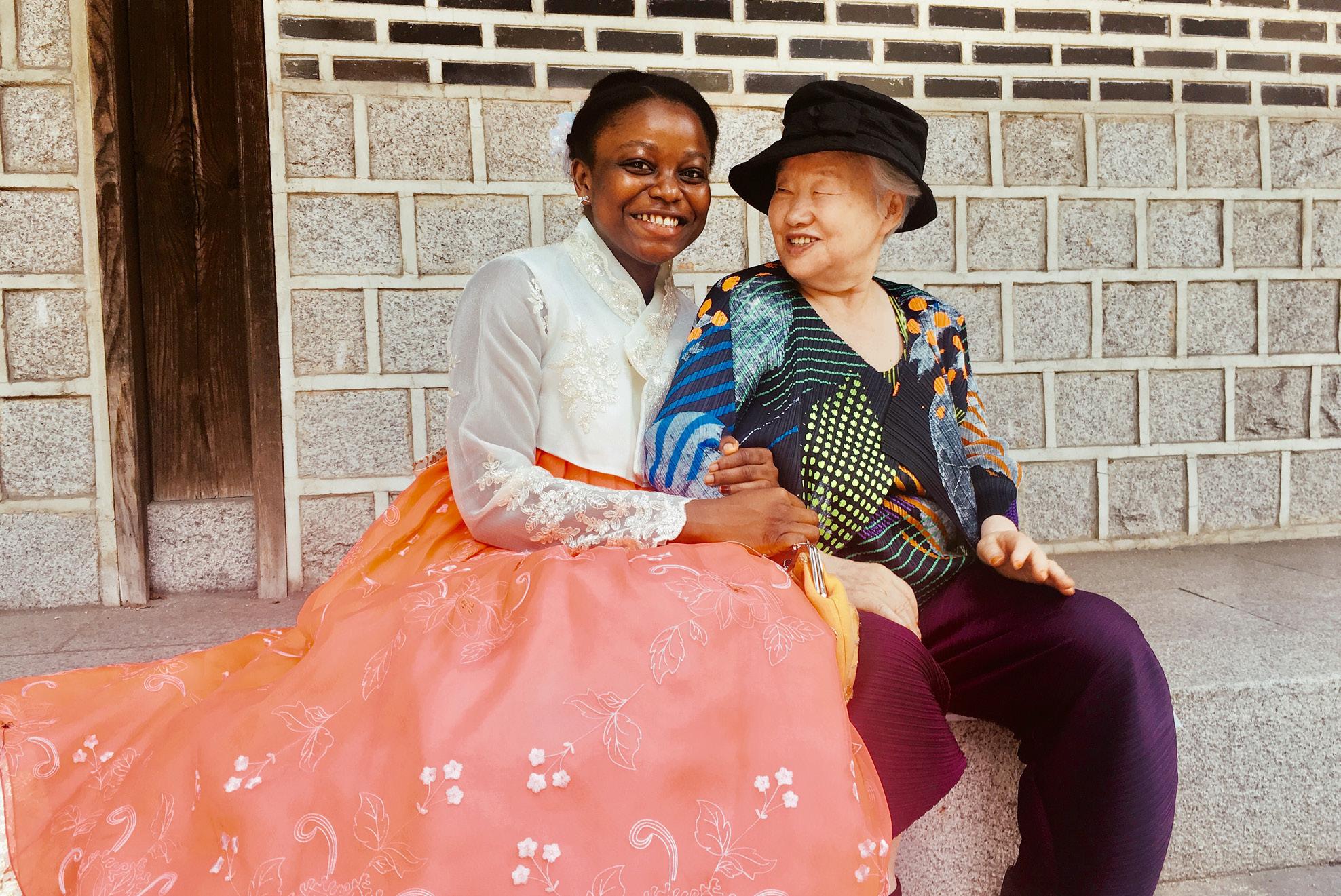
Feature Real People
Photography Samples (continued)


Natural, Spontaneous, & Engaging
Photography Samples
Images that are spontaneous and demonstrate genuine academic or cultural engagement will resonate with your audience. Avoid photos that seem posed and unnatural.


Natural, Spontaneous, & Engaging
Photography Samples (continued)


Single Subject Focus
Photography Samples
When taking a photograph of a group, select an individual for your audience to focus on, and avoid using photos that are over-complicated or cluttered.



Stay Current Photography
Samples
Regularly refresh your unit’s photo collection to ensure your images are relevant and up-to-date. Avoid using images that look or feel dated.



Phototagging
Editable Template Samples
When using photos that have been contributed by students, scholars, and faculty, it is important to include appropriate photo attribution and tagging. This helps to highlight their contributions, build a sense of community, and give our audiences a direct connection with the experiences supported by our units. The photo tagging templates in this section are downloadable frames that you may integrate and adapt for your communications and marketing material.
Examples of appropriate uses of these templates include in newsletters, brochures, social media, the website or the video wall.




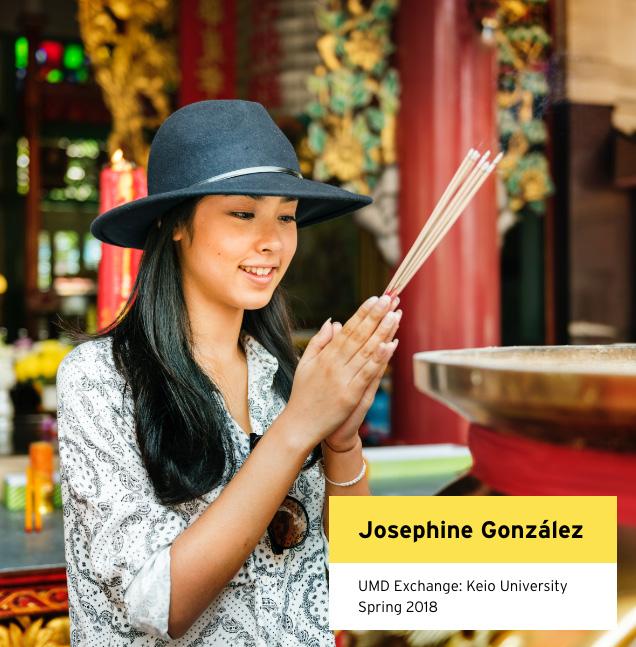

Next Steps
OIA Branding & Communications Resources
Now that you have the basic guidelines, we want you to feel empowered to implement them. To help you out, we’ve put together a shared Branding & Communications Resource Drive on Google Drive.
In it, you will find a digital copy of these guidelines, folders for each section of the guidelines containing corresponding brand assets, and a location for toolkits that will grow as OIA needs evolve.
Requesting Communications Support
Please submit any and all questions and requests for support from the OIA Communications Team to oiacomms@umd.edu.
Subject Line:
Designate which unit the request is coming from (EA, ISSS, OIA) or use OIA for general requests, and include a descriptive title. Examples include:
“ISSS: Update IOL recruitment graphic”
“OIA: Global Classrooms outreach strategy Spring 2021”
“EA: Winter 2021 brochure updates”
Email Body:
Be sure to provide a detailed description of your communications needs. Include timeline and deadline dates for deliverables. Include any necessary attachments or Google Drive links to related files.
Feedback
These guidelines and resources are meant to evolve as the needs of our department change. We welcome your feedback on how we can improve OIA’s branding and communication products and support. Contact us at oiacomms@umd.edu.
